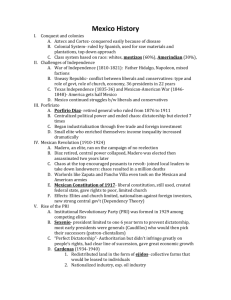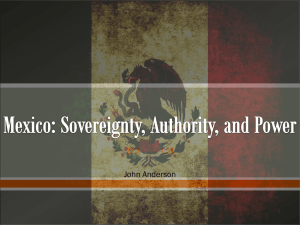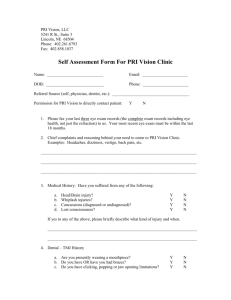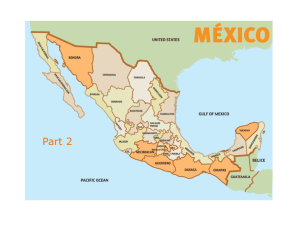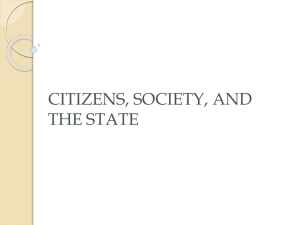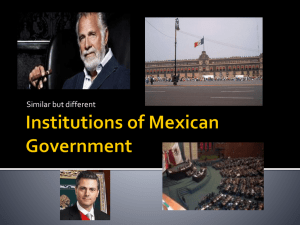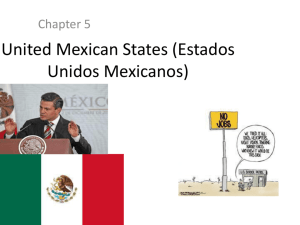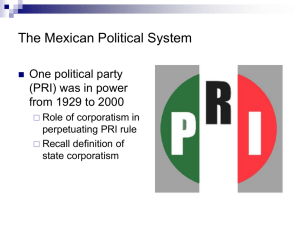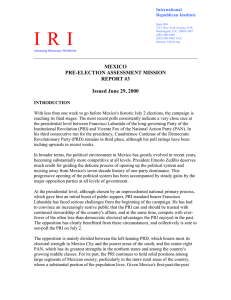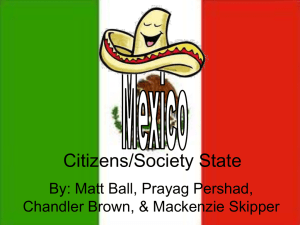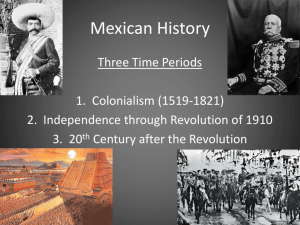Politics in Mexico
advertisement
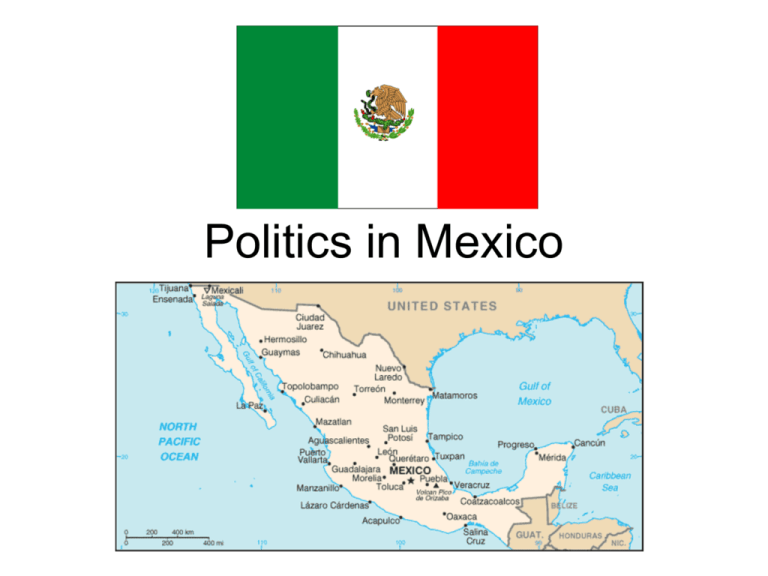
Politics in Mexico Mexico • Population – 109 million – 1/3 the population of US – Spanish, Amerindian – Roman Catholic • land area – 2 million km2 – 1/5 the size of US Colonial rule & independence • Ancient Amerindian civilizations • 3 centuries of Spanish rule • war of independence 1810 - 1821 War between Mexico & U.S. • US invaded in 1847 – Mexico City was occupied – Mexican lost most of its territory Revolution & new constitution • Mexican Revolution (1910 - 1920) – overthrew 3-decade dictatorship by Diaz • new constitution of 1917 – state control of all natural resources – subordination of the church to the state – government’s right to redistribute land – labor rights • most provisions not implemented until ’30s PRI dominance (1929-2000) • Institutional Revolutionary Party (PRI) • established by then president in 1929 • a mechanism for – resolving conflicts • sub-national personalistic political machines – co-opting newly emerging interest groups – legitimating the regime through elections • most stable regime in Latin America Democracy or not? • 1950s and 1960s – one-party democracy – incomplete political development • 1960s and 1970s – government’s massacre of student protesters – authoritarian system • subject to qualifications Democracy or not? • part-free, part-authoritarian system – has long defied easy classification: – “selective democracy” – “hard-line democracy” – or “modernizing authoritarian regime” • partly competitive elections – not necessarily fair and honest Turnout in national elections Authoritarian regime • Governments were more committed to – maintaining political stability – maintaining labor discipline • than to – expanding democratic freedoms – protecting human rights – mediating class conflict • electoral fraud and selective repression Pragmatic authoritarian regime • Institutional system, not personalistic – leadership renewal and executive succession • inclusion and co-opt – leaders of potential dissident groups – new organizations for emerging interests • repression – student protests in 1960s and 1970s – leftist militants in 1970s and 1980s Constitutional structure • On paper, Mexican government is much like the U.S. government • presidential system • 3 branches of government – legislative, executive, and judicial – checks and balances • federalism – autonomy at the local level Federal system • Federalism enshrined in 1917 constitution • often political centralism in practice – concentration of decision-making power • • • • level of govt. / share of public spending Federal government 80% Federal District & 31 states 16% 2,401 counties 4% In practice • Until late 1990s, Mexico’s system of government was very different from U.S. • highly centralized decision making – few restraints on President’s authority – President dominated legislature and judiciary • PRI controlled – both houses of the federal legislature – most public offices (political appointees) PRI’s political control • Corporatist system of interest representation – relate citizens and social sectors to the state – state-sanctioned organizations PRI’s political control • PRI itself was divided into 3 sectors – labor sector – peasant sector – popular sector • other organizations were affiliated with PRI Decline of PRI • From 1988 to 1991 PRI’s control of the Congress was significantly weakened – 260/500 seats in the Chamber of Deputies – 60/64 seats in the Senate • 1993 electoral reform – expanded opposition parties presence – in both Senate and the Chamber of Deputies • divisions within PRI PRI’s dilemma • Transform from an official government party to a competitive political party • older, less educated, and low-income voters Opposition parties • National Action Party (PAN) – urban middle class – also attracted conservative peasants and urban working class – large cities in Mexico • except Mexico City • Party of the Democratic Revolution (PRD) – Mexico City mayor Mexican Chamber of Deputies Elections (% seats won) Party 1988 1991 1994 1997 2000 2003 PRI 52 64 60 48 42 45 PAN 20 18 24 24 41 31 PRD 15 13 14 25 11 19 Others 12 5 2 3 6 6 Source: Politics in Latin America, p. 348 Mexican Presidential Elections (% popular vote) Party 1988 1994 2000 2006 PRI 51 50 36 22 PAN 17 26 43 36 PRD 31 17 17 35 Others 1 7 4 5 2000 presidential election • PAN candidate Vicente Fox won • PRI’s 71-year monopoly over presidential power in Mexico came to an end 2006 presidential election • Calderon (PAN) 36% • Obrador (PRD) 35% • Madrazo (PRI) 22% • Obrador and his supporters alleged that the election was rigged • Calderon took office in December 2006
